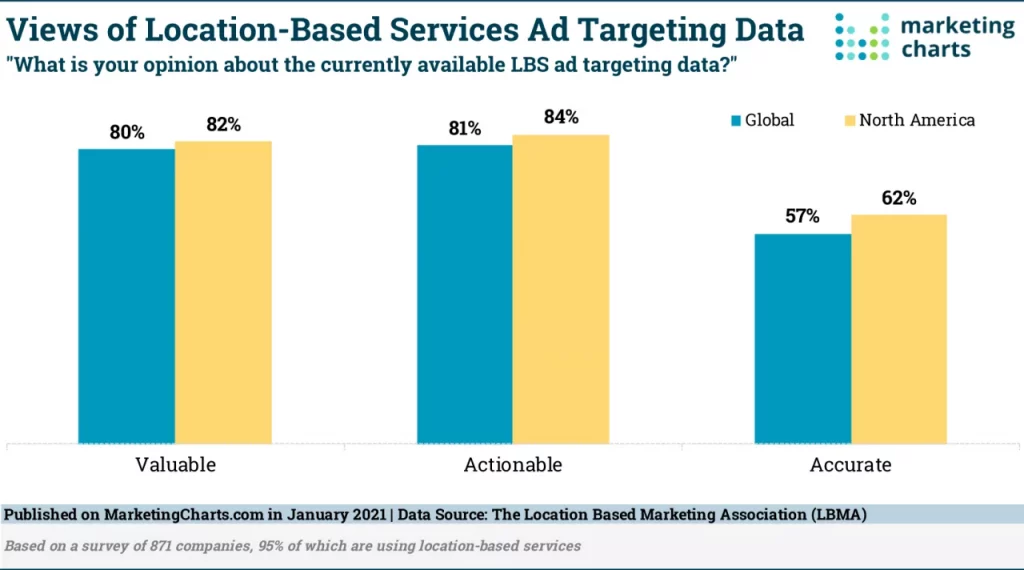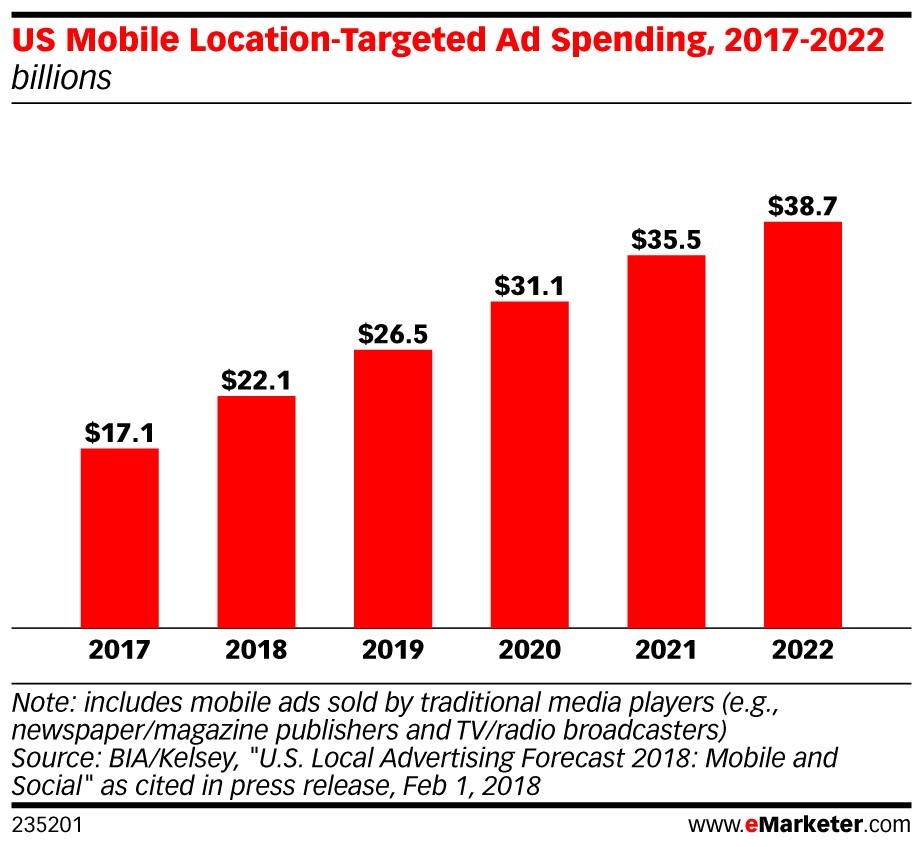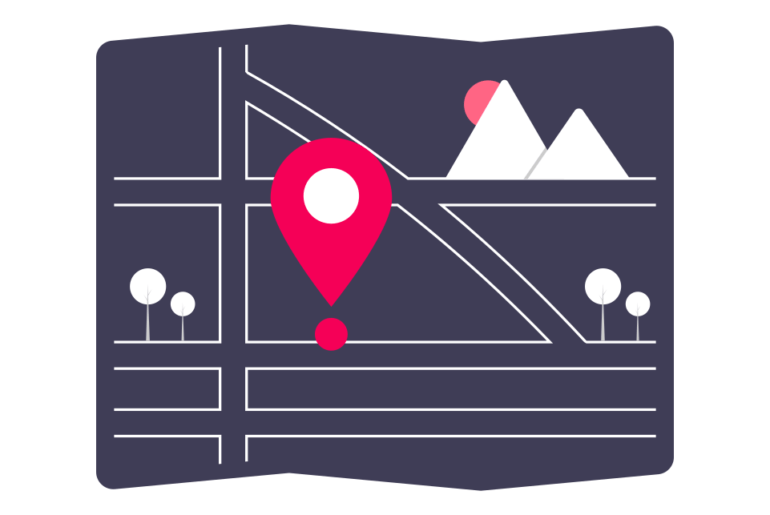Learn about the differences between two Geotargeting vs. Geofencing. Both are part of location-based targeting but serve different purposes.
Location-based marketing is a concept that has existed even before the internet did. Although it wasn’t exactly in the same shape that it is now, the concept has prevailed in many different shapes.
Whether it was the girl handing out coupons to the citizens in the streets of Paris, announcing the sale for a boutique nearby. Or it was the random flyer on your doorstep that announced the new Mexican restaurant opening nearby.
Growing through the years and with the help of many modern-day services, agencies, and software, the location-based marketing industry is currently evaluated at $5.6 billion.

The concept, simple and traditional, has seemed to work wonders for the current location-based advertising services market, and 9 in 10 marketers speak positively after having applied the same.
After all, to survive in a global economy where the competition is so saturated, one must be aware of every possible strategy that can work for their benefit.
And when the numbers speak for themselves, where location-based advertising can be 20 times more effective than simply displaying banner ads without a filter. Why not give it a whirl?
Also Read: AdPushup Insider: The Relation Between Price Floor Optimization and Geography
Topics Covered:
- Why is Location-Based Marketing Necessary to the Advertising Industry
- 5 Types of Location-Based Marketing
- How Does Geotargeting Work?
- How Does Geofencing Work?
- Differences Between Geotargeting and Geofencing
- Tips to Better Strategizing Your Location-Based Marketing
How Can Location-Based Marketing Be Beneficial to a Business
There’s a plethora of tools and services available today to strategize your location-based marketing effectively and always remain a step ahead of the competition. And as someone whose goal is to drive up revenue, here’s what location-based advertising offers:
- Higher click-through rates as location-targeted ads are more relevant and effective in client conversion.
- Creating a better user experience by focusing more on the client’s needs than bombarding them with random ads.
- Raising your quality of sponsors as the central focus is created on the advertiser that is being endorsed, steering away the focus from the competition.
- Location-based marketing doesn’t just focus on the where but when. And reaching out to the audience at the right time is greatly responsible for driving a higher ROI.
- If you feel your revenue is facing a quiet period, as is natural for the shifts in revenue generation for advertisers and publishers. Location-based advertising may just be the leverage you need to drive up your revenue.
Also Read: The Future of Ad Tech: VR, AR, and Location-Based Targeting
Location-Based Marketing – Types
Having gone through massive shifts and developments, location-based marketing today is a shape that was far from imaginable, even a few years ago. Even this is a large umbrella term under which marketers take several approaches to strategize better. The 5 types that are commonly taken to by advertisers and publishers as an attempt at location-based advertising are discussed briefly below:
- Geotargeting
Geotargeting works by leveraging the IP address of a user and personally reaching out to them, messaging them about the relevancy of their location. Say you enable access to location on an app, and then the app notifies you of an interesting offer or opportunity banking on the regional information or the user’s proximity to the nearby store.
- Geo Conquesting
Geo Conquesting is a concept that works by steering clientele away from a competitor and towards the source business. Say you are about to visit a store for a certain purpose, but as soon as you cross the marked boundary, you get a better offer for the same deal to a different store nearby. This, too, works by tracking the user’s location data.
- Geofencing
Geofencing is the creation of the aforementioned boundary. It creates an active location fence, and any user that crosses said boundary becomes an action to get to the advertising campaign, banking on the regional reach of the user.
- Mobile Targeting

Mobile targeting is simply utilizing geotargeting and geofencing and advertising users on their mobile according to their location data and once they cross the specific fence and are near the store. - Beaconing
This is a process where certain devices i.e. beacons, have been installed that work on Bluetooth or wifi and send signals to mobile devices. Say a phone with an installed application for the relevant brand or business enters a territory, and the beacon identifying the same sends relevant marketing messages to the particular device.
How Does Geotargeting Work?
Geotargeting is a marketing tool that, for effective advertising, uses the geographic location of a user and shows ads accordingly. It can work country-wise, capital-wise, city, district, or even a small particular region. Geotargeting is a concept relevant not just to advertising as it is of great help to the public as well.
Say, for instance, you are visiting a new place and are looking for a place to eat; your first step would be to web search ‘restaurants near me.
Geotargeting can be divided into three categories – local, hyper-local, and advanced geographic targeting.
Local targeting is where advertisements are displayed within the same area or region. Hyper-local targeting is when a specific location is chosen, say up to 1000 meters around a store, and ads are displayed accordingly. Advanced geographic targeting is where any user searching for a specific location is displayed the word accordingly. Here the geographic location of the user is immaterial.
How Does Geofencing Work?
Geofencing uses several tools and services, like Wi-fi, cellular data, RFID, and more, to set a specific perimeter around a particular location. And once a device crosses said perimeter or searches up the set location, brochures, coupons, notifications, text messages, emails, and other forms of advertising becomes activates.
Geofencing is a concept not just relevant to marketing but in the fields of aviation, logistics, smart home control, and so on.
Geotargeting vs. Geofencing: Key Differences
So, now that we’ve covered a basic description of Geotargeting and Geofencing, here’s a breakdown of the differences between the two.
| GEOTARGETING | GEOFENCING |
|---|---|
| Geotargeting works on raising more brand awareness and securing future conversions, | Offers a Uber-relevant advertising experience to the potential leads for quick conversion. |
| Usually works by setting a broad geographic boundary, based on say a city, country, or town. | Geofencing works on a much narrow and more focused area, by setting a fence around a specific geographic location. |
| Geotargeting is usually combined with other filters and advertises in a hyper-personalized manner i.e. not all users inside the selected area will receive the notifications. | Geofencing works by sending notifications to anyone and everyone who enters said parameter or searches for the location. |
| Geotargeting doesn't store the user's location data. | Geofencing not only collects the user's location data but stores store their location history. |
| Geotargeting is used by almost every kind of business. | Geofencing is used by specifically event agencies, advertisers, and business owners. |
| Geotargeting depends on a user's IP address. | Geofencing leverages GPS, Wi-Fi, cellular data, and so on. |
Wrapping Up!
Often advertisers and publishers are overwhelmed as to which is the better choice for them, and understanding the differences, i.e. Geotargeting vs Geofencing, can be helpful. While they may have similar targets and function under the same umbrella, they function distinctly.
It depends more on the brand whether geotargeting or geofencing will work more effectively. However, one can test out both and assess better for themselves. And plenty of geofencing and geo-targeting-specific platforms can be of help.
FAQ – Geotargeting vs Geofencing
Geofencing or any form of location-based marketing can offer an array of benefits. For instance, geofencing can help by better allocation of marketing budget, boosting up the sales rate, offering hyper-relevant advertising and, in turn, user experience, and so on.
There are many steps you can take to better your location-based marketing strategy, and using relevant geotargeting or geofencing platforms is one of them. Other practices can include – finding out locations that your users tend to frequent and advertising accordingly, creating location-based landing pages, targeting the competitor’s location and applying geo-conquesting, and so on.
Since Geofencing works by combing services like GPS, Wi-Fi, cellular data, and more it provides the ultimate accuracy needed in location-based advertising. Even in rural areas where the necessary services are lacking accuracy can reach up to hundreds of meters.

Shubham is a digital marketer with rich experience working in the advertisement technology industry. He has vast experience in the programmatic industry, driving business strategy and scaling functions including but not limited to growth and marketing, Operations, process optimization, and Sales.




![CTV vs OTT Advertising: Which one is Right Pick for Publishers? + [6 Bonus Strategies] Ott vs Ctv](https://www.adpushup.com/blog/wp-content/uploads/2023/02/Featured-Image-270x180.png)


